This contemporary Rockwell design is a radical change from the standard studio technique. These figurines are cast from pewter (an alloy of tin, lead and antimony) instead of bronze. Preserving the integrity of the Rockwell work was foremost in everyone's thoughts. That meant the covers from the Saturday Evening Post had to be reproduced exactly as Normal [sic] Rockwell drew them, including the heading and date. Some of the Rockwell reproductions for sale today have modified the look so much that is is sometimes hard to recognize the origin.
The size of a sculpture is determined by what one is trying to achieve. In this case, the studio wanted the date to be readable, and that determined the size.
They first attempted to cast in bronze. However, the samples turned out much too dark. On a trip to Boston, Bob visited several collectible stores that sold pewter, and the choice soon became obvious. In pewter, the figurines took on a distinctive"American look."
These figurines are carved from back to front. There are three steps: engraving the back cover, carving the bas-relief coming off from and attached to the back, and the freestanding figurine. The transition in size from the back to the front had to be gradual. If it came out too fast, the appearance would be that of a figurine stuck in front of a cover. If it came out too gradually, then the appearance would be too shallow. The transition distance, or depth, also had to be uniform, so all the figurines of the series looked good together.
The doctor and the little girl with her doll came out slightly flat, due to the shrinkage factor of pewter. There is a compression of the metal during casting. This flatness will be noted on several of the figurines. This was difficult to judge because the shrinkage acted very differently from bronze. Since pewter is a softer metal, restrictions are placed on long, thin items, such as Rockwell's pipe and paint brush in "Triple Self Portrait." That characteristic also made casting out detail more difficult.
While Bob was carving this figurine, he was not sure how the finishing would be done. he needed to wait for the first castings to experiment with decorating. His options ranged from full color to an all natural, antiqued finish. After long periods of trying different techniques, the current method of painting only one figurine emerged. What a unique effect!
All these figurines are at least two-piece molds, and the separate figurines are soldered in place, quite a departure from the regular methods. The only carvings prior to this with more than one mold were the ladder in "Cherry Pickers," the base of "Kuan Yin," and the "Floral Bouquet Pompadour," which is two halves glued together.
A patina, which is selectively buffed out before painting is applied to the entire figurine. That is how the darks and the lights are obtained. This buffing is all done by hand, just as with the natural bronzes.
A brown, oil-based stain is used on some of the intermediate-depth figurines or objects. The overall effect is visually arresting, causing the viewer to evaluate what is going on.
Note that some of the bases are tipped. If they were not, the second girl in "Check Up," for instance, would have been brought farther forward and made the same size as the front girl. This would have altered the original artwork and would not have been acceptable to the studio. To maintain the proper depth perspective, the base had to be tipped upwards towards the back. The studio work is an accurate interpretation and maintains the integrity of the original artwork.
The eyes on the unpainted figurines are carved into the figurine. Note their depth and detail. The eyes on the painted characters would have filled up with paint, even if carved, so just a shadow effect was used. The eyes on the boy in "Bottom Drawer" are decals.
These figurines are unique in design and execution. Such an interpretation has never been done before and certainly has added another dimension to pewter. This technique grants the ability to translate complex themes and paintings into three-dimensional sculpture. The studio will continue to pursue this technique in other projects.
To view the entire Rockwell Collection created by Olszewski for Goebel Miniatures in a display, click here.
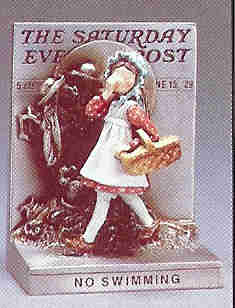
First Issued: 1988 Price: $85.00
Studio Mark: 360-P
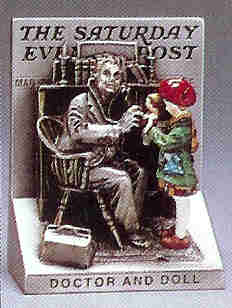
First Issued: 1988 Price: $85.00
Studio Mark: 361-P
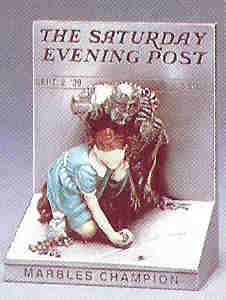
First Issued: 1988 Price: $85.00
Studio Mark: 362-P
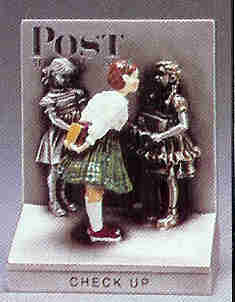
First Issued: 1988 Price: $85.00
Studio Mark: 363-P
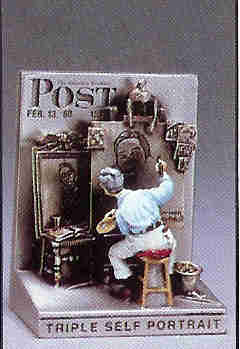
First Issued: 1988 Price: $85.00
Studio Mark: 364-P
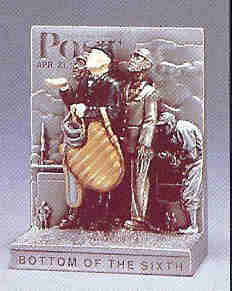
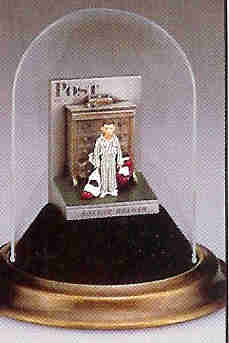
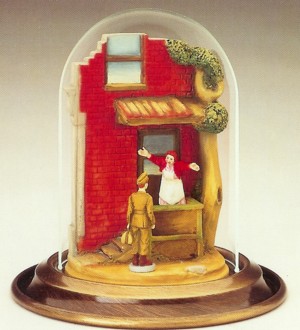
First Issued: 1988 Price: $85.00
Studio Mark: 365-P
First Issued:1989 Price: $85.00 Studio Mark: 365-P
First Issued: 1991 Price: $85.00